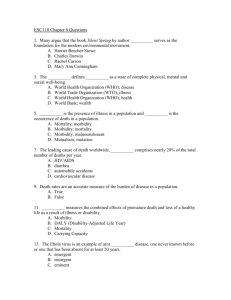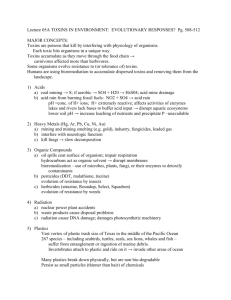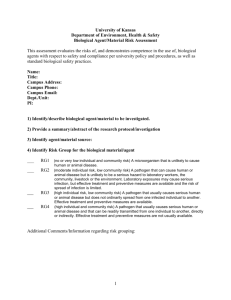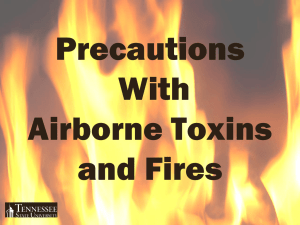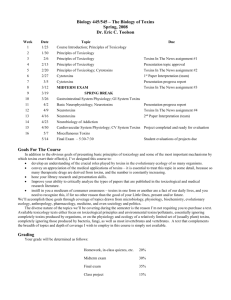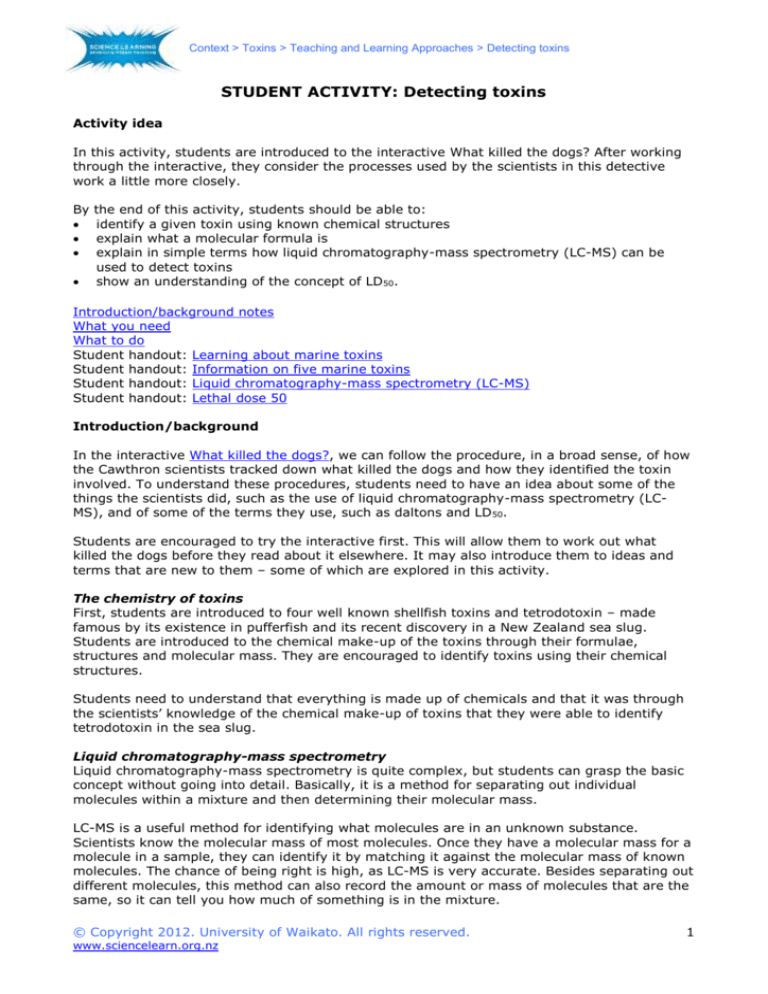
Context > Toxins > Teaching and Learning Approaches > Detecting toxins
STUDENT ACTIVITY: Detecting toxins
Activity idea
In this activity, students are introduced to the interactive What killed the dogs? After working
through the interactive, they consider the processes used by the scientists in this detective
work a little more closely.
By
the end of this activity, students should be able to:
identify a given toxin using known chemical structures
explain what a molecular formula is
explain in simple terms how liquid chromatography-mass spectrometry (LC-MS) can be
used to detect toxins
show an understanding of the concept of LD50.
Introduction/background notes
What you need
What to do
Student handout: Learning about marine toxins
Student handout: Information on five marine toxins
Student handout: Liquid chromatography-mass spectrometry (LC-MS)
Student handout: Lethal dose 50
Introduction/background
In the interactive What killed the dogs?, we can follow the procedure, in a broad sense, of how
the Cawthron scientists tracked down what killed the dogs and how they identified the toxin
involved. To understand these procedures, students need to have an idea about some of the
things the scientists did, such as the use of liquid chromatography-mass spectrometry (LCMS), and of some of the terms they use, such as daltons and LD 50.
Students are encouraged to try the interactive first. This will allow them to work out what
killed the dogs before they read about it elsewhere. It may also introduce them to ideas and
terms that are new to them – some of which are explored in this activity.
The chemistry of toxins
First, students are introduced to four well known shellfish toxins and tetrodotoxin – made
famous by its existence in pufferfish and its recent discovery in a New Zealand sea slug.
Students are introduced to the chemical make-up of the toxins through their formulae,
structures and molecular mass. They are encouraged to identify toxins using their chemical
structures.
Students need to understand that everything is made up of chemicals and that it was through
the scientists’ knowledge of the chemical make-up of toxins that they were able to identify
tetrodotoxin in the sea slug.
Liquid chromatography-mass spectrometry
Liquid chromatography-mass spectrometry is quite complex, but students can grasp the basic
concept without going into detail. Basically, it is a method for separating out individual
molecules within a mixture and then determining their molecular mass.
LC-MS is a useful method for identifying what molecules are in an unknown substance.
Scientists know the molecular mass of most molecules. Once they have a molecular mass for a
molecule in a sample, they can identify it by matching it against the molecular mass of known
molecules. The chance of being right is high, as LC-MS is very accurate. Besides separating out
different molecules, this method can also record the amount or mass of molecules that are the
same, so it can tell you how much of something is in the mixture.
© Copyright 2012. University of Waikato. All rights reserved.
www.sciencelearn.org.nz
1
Context > Toxins > Teaching and Learning Approaches > Detecting toxins
Lethal dose
Students should also have some idea about lethal dose. LD50 is a measurement in toxicology
that indicates how poisonous something might be, which is really important for people to
know. It is the dose required to kill half of a specific animal population. Since LD 50 is obtained
through causing the death of animals, it may be a problem for some students. The
Biotechnology Learning Hub case study Ethics of using animals in research could be a useful
teaching activity helping students understand the science involved and to consider wider
viewpoints.
Finally, students should be encouraged to try the What killed the dogs? interactive again, this
time focusing more on the procedures used to identify the sea slug and the toxin rather than
the result.
What you need
Access to the interactive What killed the dogs?
Access to or copies of the articles Monitoring shellfish, Sea slugs and TTX, Chemicals
everywhere and Measuring toxicity
Access to the video clip Identifying the toxin
Copies of the student handouts Learning about marine toxins, Information on five marine
toxins, Liquid chromatography-mass spectrometry (LC-MS) and Lethal dose 50
What to do
1. Have students work through the interactive What killed the dogs? in pairs and make a list
of terms and ideas they found difficult to understand.
2. Have students find out about some marine toxins. Read Monitoring shellfish, Sea slugs and
TTX and Chemicals everywhere in groups or as a class. Use this information plus the
Information on five marine toxins to answer the questions in Learning about marine toxins
in pairs.
3. Have students learn about liquid chromatography-mass spectrometry. As a class, watch the
video clip Identifying the toxin, then have students work through Liquid chromatographymass spectrometry (LC-MS) with a partner.
4. Have students learn about LD50. Read Measuring toxicity as a class or in groups, then have
students read and discuss Lethal dose 50 using the questions in pairs.
5. Work through the interactive What killed the dogs? again.
© Copyright 2012. University of Waikato. All rights reserved.
www.sciencelearn.org.nz
2
Context > Toxins > Teaching and Learning Approaches > Detecting toxins
Student handout: Learning about marine toxins
1. What is okadaic acid? How are people poisoned by okadaic acid? What is the origin of
okadaic acid? What type of poisoning does it cause (in relation to how it affects people)?
What are the symptoms of the poison?
2. What is tetrodotoxin (TTX)? How might people be
poisoned by TTX? What type of toxin is it? What are the
symptoms of the poison?
3. What are the molecular formulae for okadaic acid and
tetrodotoxin? What do the letters C, H, O, and N stand for? Check the periodic table in
Chemicals everywhere. Explain the numbers that follow each element.
4. Here are some chemical structures for some marine toxins. These structures show how the
molecules in the toxin are made up or formed. Use the student handout Information on
five marine toxins to identify the chemical structures of these toxins.
© Copyright 2012. University of Waikato. All rights reserved.
www.sciencelearn.org.nz
3
Context > Toxins > Teaching and Learning Approaches > Detecting toxins
Student handout: Information on five marine toxins
Toxin
Molecular formula and structure
Brevetoxin
C52H74NO17SNa
Molecular mass
(daltons)
Neurotoxic shellfish
poisoning (NSP)
Okadaic acid
805
200
319.28
10
294
10
311.14
3600
C10H15N7O4
Paralytic shellfish
poisoning (PSP)
Domoic acid
200
C11H17N3O8
Neurotoxin
Saxitoxin
1039
C44H68O13
Diarrhetic shellfish
poisoning (DSP)
Tetrodotoxin
(TTX)
LD50
(µg/kg in mice)
C15H21NO6
Amnesic shellfish
poisoning (ASP)
© Copyright 2012. University of Waikato. All rights reserved.
www.sciencelearn.org.nz
4
Context > Toxins > Teaching and Learning Approaches > Detecting toxins
Student handout: Liquid chromatography-mass spectrometry (LC-MS)
Liquid chromatography-mass spectrometry is a
sophisticated laboratory technique.
Very briefly, when samples are loaded into the
instrument, the liquid chromatography (LC) part
separates the molecular components present.
These then enter the mass spectrometer (MS) where
the molecular mass of each component is determined.
The amount of a given component (pure substance)
present can also be determined.
The unit for this measurement of molecular mass is given in daltons. One dalton is
approximately equal to the mass of one proton or one neutron. Scientists have already worked
out and recorded the molecular mass for most molecules. This means that, when they are
given a molecular mass through LC-MS, they can look up that mass to find out what the
molecule is.
Using the student handout Information on five marine toxins, answer the following
questions:
1. Which of the five toxins has the heaviest molecule?
2. Which has the lightest?
3. What is the molecular mass of tetrodotoxin?
4. What is the molecular mass of okadaic acid?
5. According to the interactive What killed the dogs?, which toxin was found in the greatest
quantities?
6. What was the name of the other toxin detected?
7. Molecular mass is measured in daltons. This was named after John Dalton. Find out who
John Dalton was.
© Copyright 2012. University of Waikato. All rights reserved.
www.sciencelearn.org.nz
5
Context > Toxins > Teaching and Learning Approaches > Detecting toxins
Student handout: Lethal dose 50
Lethal dose 50 (LD50) is a very useful measurement in toxicology. It is the dose required to kill
half of a specific animal population. It tells us how poisonous a substance is. In the example
given in Measuring toxicity, salt has an oral (means it was fed to an animal) LD50 of 3 gm/kg
in rats. Paracetamol has an oral LD50 of 1.944 gm/kg in rats. This means paracetamol is more
poisonous than salt because a smaller amount of paracetamol will get the same result in rat
deaths.
The LD50 of the toxins in the student handout Information on five marine toxins was
calculated using mice and is measured in micrograms (µg). A microgram is just one-millionth
of a gram. A small paper clip might weigh a gram, so a microgram is one-millionth of that. It is
not something you can see with your eyes. A kilogram is a billion micrograms, so one part per
billion of solid measure is equal to a µg/kg.
Discuss these questions together:
1. What is the LD50 of okadaic acid?
2. What is the LD50 of tetrodotoxin?
3. Which is more toxic? Explain why
4. Which of the five toxins is/are the most deadly? Explain why.
© Copyright 2012. University of Waikato. All rights reserved.
www.sciencelearn.org.nz
6


